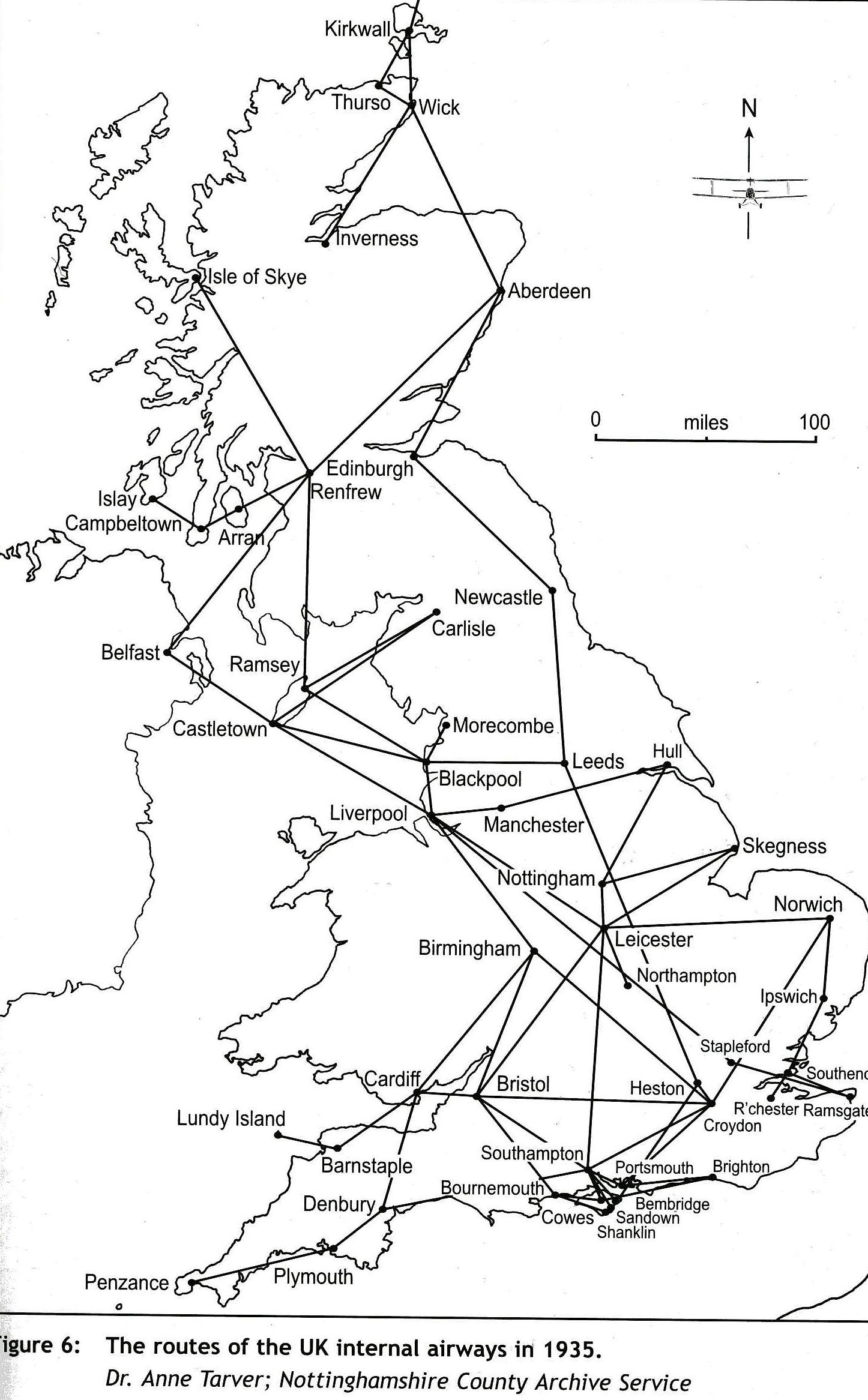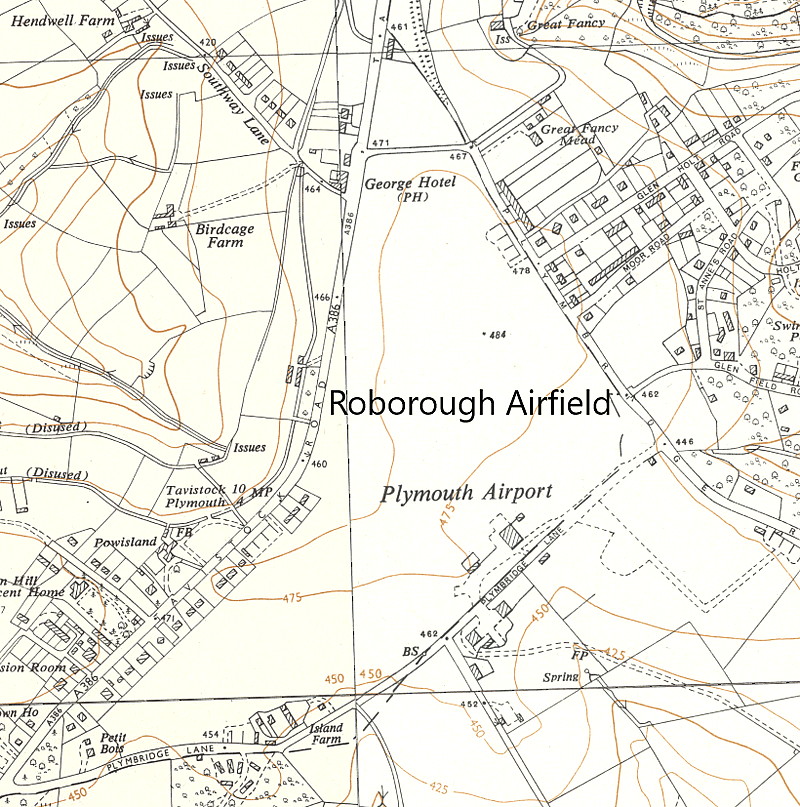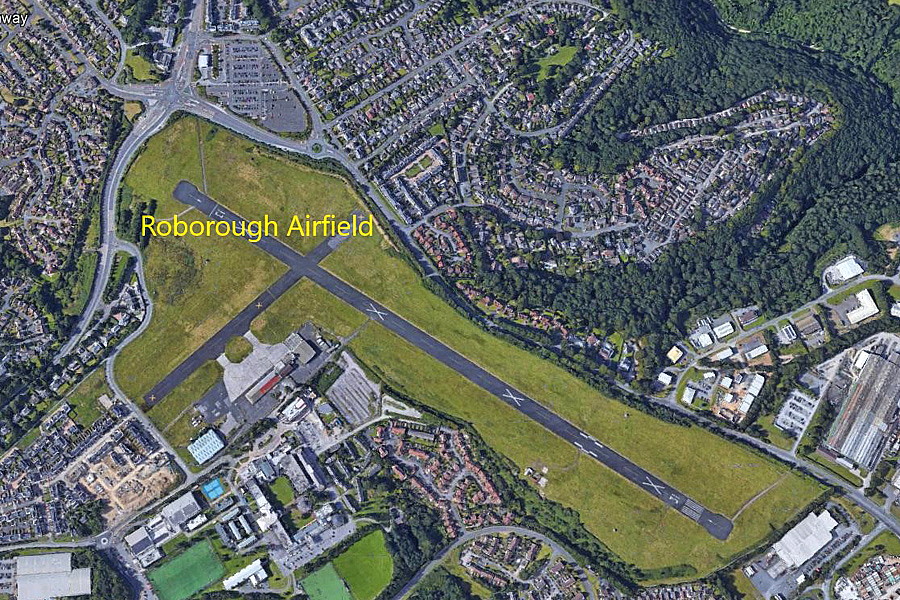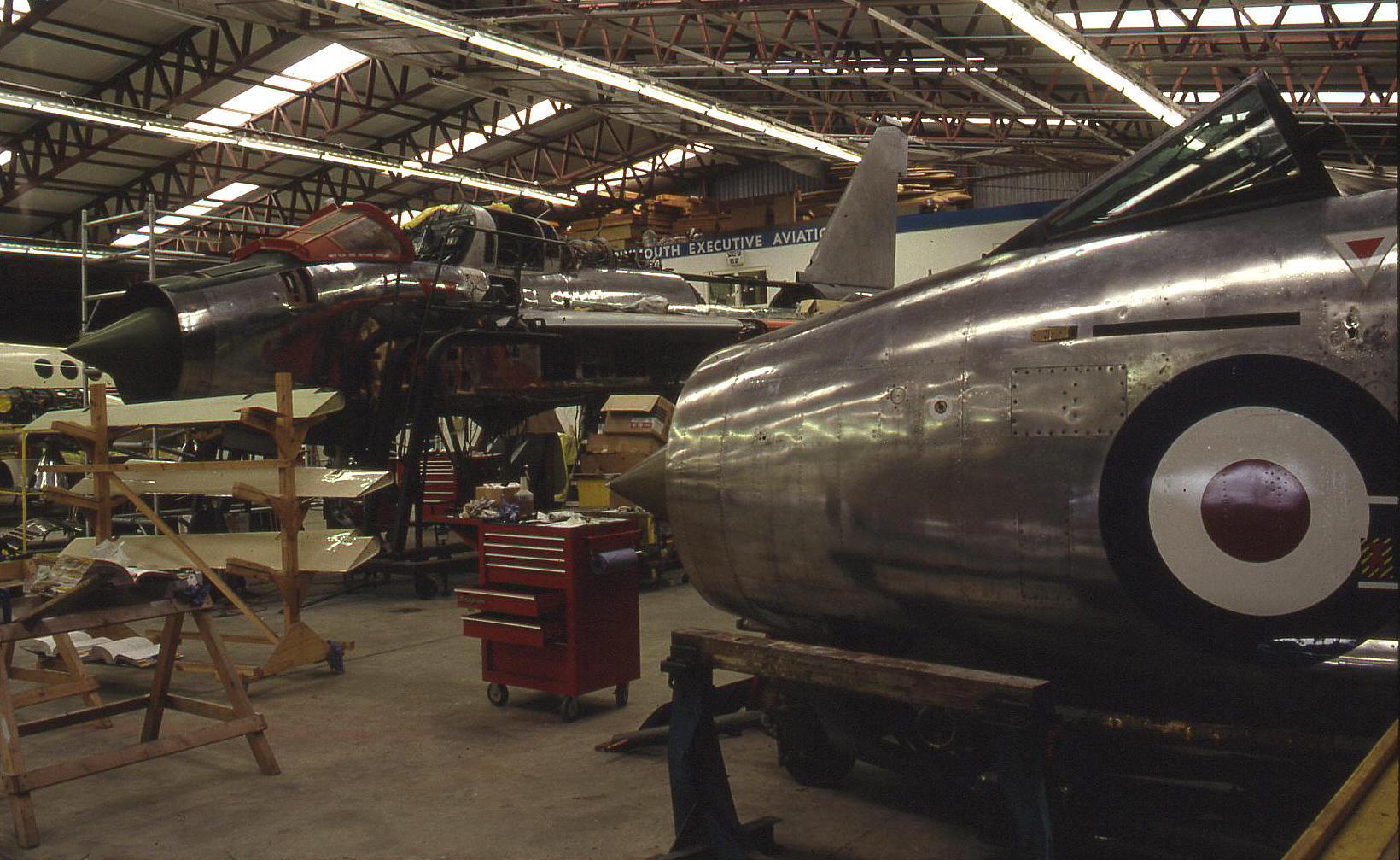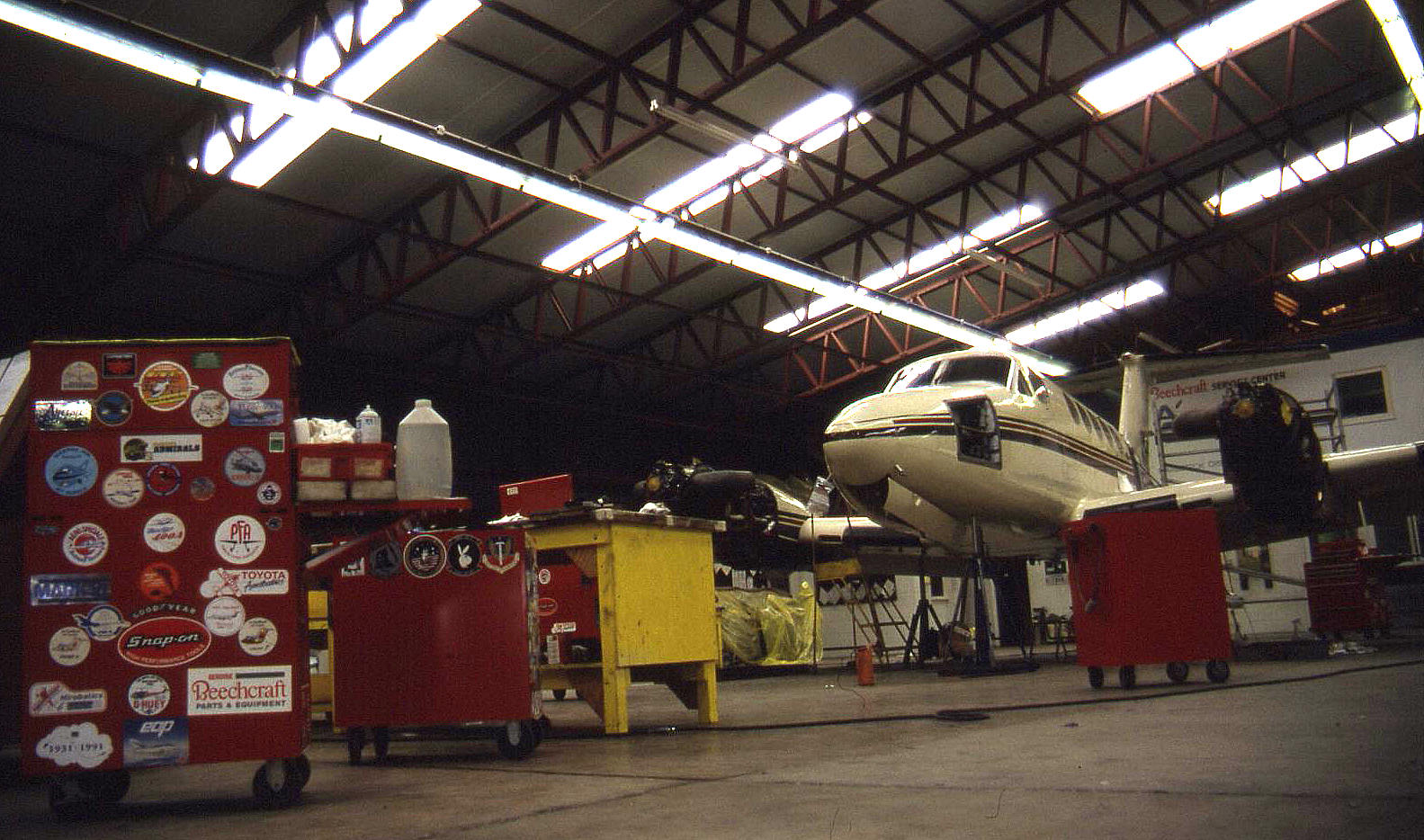Plymouth Airport
PLYMOUTH: Civil regional airport, later military aerodrome during WW2 (?), reverting again to civil regional airport after (?)
(Previously known as ROBOROUGH and CROWN HILL)
Notes: The first item is from my Google Earth © derived database. The second picture was taken by me on a very dull day when departing PLYMOUTH in 1992.
The third illustration was provided by Maurice J Wickstead. As can be seen, if you look closely, PLYMOUTH (Airport of Plymouth) is also listed as a destination in the Provincial Airways advert.
ICAO code: EGHD IATA code: PLH
Note: This fabulous picture, (c/o A.J.Jackson), of Martin Hearn on the top wing of the CAC (Cornwall Aviation Company) Avro 504K G-ABHI, diving towards the crowd at ROBOROUGH has been scanned for the excellent book Cornwall Aviation Company by Ted Chapman. He mentions in his caption that: A.J.Jackson describes this picture as 'horrific'.
Clearly A.J. Jackson had no idea whatsover about flying. Without any doubt the photographer captured a truly great angle to make a stunning picture. But, as a pilot and photographer, I can explain that the dive angle is actually quite shallow and the bank angle will take the aeroplane away from the crowd. In fact quite a safe manoeuvre, and without much doubt performed many times before.
Operated by: 1933: Surrey Flying Services on behalf of Plymouth City Council
1965: Plymouth Airport Ltd
1984: Brymon Airports Ltd
1990/2000: Plymouth City Airport Ltd
Civil activities: Airline, charter, GA business, private and training. Maintenance for GA
Military users: WW2: RAF Coastal Command
691 Sqdn (Hurricanes/Martinets/Vengeance TTs)
RN Basic Training
US First Army ‘V’ Corps 29th Infantry Division. Also 111th Field Artillery Battalion?
1975/1984: RN Flying Grading Unit (Chipmunks)
Post 1945: RNAS NFGF plus using civil contractors Bond Helicopters for RN communications and other duties
Note: The first map copyright Dr Anne Tarver. Nottinghamshire County Archive.
British airline users: Pre 1940: Channel Air Ferries, Crilly Airways, Great Western Railway Air Service, Great Western & Southern Air Lines, Imperial Airways, International Air Lines, Lundy & Atlantic Coast Airlines, Provincial Airways, Railway Air Services, Western Air Express, West Country Air Service
Note: Both these pictures from postcards were kindly sent by Mike Charlton (see below) and both served with Provincial Airways based at CROYDON for a fairly short period in the 1930s for their services to the west Country.
As is so often said, a picture is worth a thousand words. This picture from a postcard was kindly sent by Mike Charlton who has an amazing collection, See, www.aviationpostcard.co.uk
I suspect Brymon Airways were operating this service in BA colours? Any advice is much welcome.
Post 1945: Air Southwest, British Westpoint, Brymon Aviation later Brymon Airways, Jersey Airlines, Mayflower Air Services, Skybus, Westward Airways
Charter/air taxi: Post 1945: Air Gregory, Cabair, Western Airways
Flying schools: Post 1945: Aviation South West, Plymouth Aero Club, Plymouth School of Flying
Note: In the 1957 The Aeroplane directory, Plymouth Aero Club are listed as operating one Miles M38 Messenger, three DH82A Tiger Moths, one Auster and one Miles M65 Gemini.
Maintenance: Post 1945: Maersk
Location: E of A386, SW of Glenholt, NE of Crownhill, 4nm NNE of Plymouth
Period of operation: 1931 to 2011
Note: These maps are reproduced with the kind permission of Pooleys Flight Equiment Ltd. Copyright Robert Pooley 2014.
Runways: 1933: Max landing run 713 grass
WW2: NW/SE 732x91 grass NE/SW 823x91 grass E/W 549x91 grass
1965: 06/24 957 grass 14/32 518 grass 01/19 841 grass
1990: 06/24 752x26 hard 13/31 1190x30 hard
2000: 06/24 752x26 hard 13/31 1170x30 hard
NOTES:
It appears that the "Flying Circus" operators were the first to use ROBOROUGH, but, in 1929 Sir Alan Cobham’s UK Municipal Aerodrome Campain tour used the Polo Ground at ROBOROUGH as his 67th Plymouth venue. He had planned to visit 107 venues, mostly in England but with eight in Scotland, and two in South Wales. In the end, after a couple of crashes and other setbacks, he managed to visit 96 venues, which of course was still a magnificent achievement.
The aircraft he mostly used for this Tour was the ten-seater DH61 'Giant Moth' G-AAEV named 'Youth of Britain'. The punishing schedule he set for himself seems astonishing today. I can also highly recommend reading his memoirs in 'A Time To Fly'.
A MICHAEL T HOLDER GALLERY
Note: Without too much doubt the aerial photo above was taken in the 1930s? Almost certainly before the Royal Navy started using it for flying training duties. The third item was published in the Western Morning News on the 24th August 1929.
Note: The fifth item above is, without doubt, a composite picture - a common enough trick of the trade. The difference in the colour of the sky being the giveaway here. The sixth item is most unflattering for Sir Alan - you'd have thought the photographer should have had enough presence of mind to allow him to straighten up and smooth his hair after he'd removed his flying helmet.
A SUCCESS FOR COBHAM?
The main objective of Sir Alan Cobham's 1929 Municipal Aerodrome Campaign was to extol the benefits of towns having an aerodrome/airport. It seems reasonable to suppose that, in some part at least, his visit inspired the City Council to provide one.
Without much if any doubt, this venue subsequently become the site of the present airport opened in 1931. The next year, (20th August 1932), Alan Cobham’s National Aviation Day UK Display Tour gave their Plymouth venue as Roborough Aerodrome.
A simply astonishing picture appears in Colin Cruddas’ superb book ‘Those Fabulous Flying Years’, (P.62), taken air-to-air of Martin Hearn ‘wing walking’ on a Avro 504K in August 1932 at Roborough with no visible means of restraint let alone a ‘zimmer frame’ and harness! Not surprisingly this ‘act’ was dropped for the next years tour.
Venue (24th August) for Cobham’s 1935 No.1 Tour.
THE EARLY AIRLINES
Throughout my research I have been beset by so many accounts giving different details, often if not usually from sources accredited as being expert. For example I made the comment some time ago that: It appears that Great Western Railway Air Service were the first to establish a regular airline service from ROBOROUGH, the inaugural service on the 12th April 1933, linking Plymouth to Teignmouth (HALDON) and Cardiff (PENGHAM MOOR?) using the Westland Wessex G-AAGW. The service was extended to Birmingham (CASTLE BROMWICH) on the 22nd May 1933.
But – this now appears incorrect (?) – this service by Railway Air Services started in 1934*. The first service to ROBOROUGH it seems was actually in August 1933 by International Air Lines Ltd who operated two Monospar ST.4s G-ABVN and G-ACJF on a CROYDON – PORTSMOUTH – EASTLEIGH (Southampton) – ROBOROUGH route. It lasted for just ten days. In October 1933 Provincial Airways was formed to take over the International service using just one DH Fox Moth G-ACCF. It now appears the service operated for just two days on the 25th and 26th November 1933 before being suspended due to the ill health of the managing director Harry Kent. Provincial Airways did however resume operations in March 1934.
I reckon it is worth mentioning that the grandly titled International Air Lines opened a service from CROYDON via PORTSMOUTH and/or Southampton (EASTLEIGH) to Plymouth (ROBOROUGH) on the 24th August 1933 with two Monospar ST.4s, G-ABVN and G-ACJF. About ten days later they had gone bust!
*Railways Air Services started operations on the 7th May using the DH.84 Dragon G-ACPX and these continued to the 29th September 1934. The service started here and linked to Liverpool (SPEKE) via Teignmouth (HALDON) – Cardiff (PENGHAM MOOR) and Birmingham (CASTLE BROMWICH).
WORLD WAR 2
It seems that during WW2 Roborough was mostly ignored as a potential aerodrome for front line operations. Possibly influenced by the hammering Plymouth had received in the first two years of WW2. But, at a certain period during WW2 the US Army had eighteen or more L-4 Grasshoppers based here.
POST WW2
In his excellent book Tiger Moth Stuart McKay tells us of a most unusual adventure: “HMS Eagle completed a major re-fit at Plymouth in 1964 and on June 20th the ship was working-up in the Western Channel, prior to receiving her squadrons. When it was suggested that Tiger Moths attached to the Britannia Royal Naval College at Dartmouth might care to assist in the ship’s training programme, Naval signals establishments were suddenly busy with traffic seeking the necessary approvals.”
Four Tiger Moths set off from Roborough in perfect conditions, located and landed on Eagle, and struck down, (My note: removed from the deck via lifts), prior to the ship altering course out of wind. The landings provided excellent handling practise for the flight deck crew. No doubt the aviators tested the wardroom facilities too before leaving, Plymouth bound, after yet another special Tiger Moth occasion.” I wonder how much instruction the deck crew received on how to handle flimsy fabric covered aircraft?
BRYMON AIRWAYS
Some say Brymon Aviation was formed at FAIROAKS in SURREY and eventually became Brymon Airways, based here in 1974. Others say Brymon Aviation was formed at THRUXTON (HAMPSHIRE) in 1969. They became the UK launch customer for the DHC-6 Twin Otter, and the rest, as they say, is history! The problem in becoming older in life is that you remember things from many years ago, like seeing pictures of Twin Otters with piston radial engines - and by simply pointing this out you automatically become a sad and pedantic old fart.
It now appears that the company was incorporated on the 26th January 1970 as Brymon Aviation Limited operating as Brymon Airways. It seems Brymon Airways, based both here and at St MAWGAN (NEWQUAY) in CORNWALL soon established a network around the UK, including the Channel Islands, the Isles of Scilly and both GATWICK and HEATHROW, plus destinations in France. According to Wikipedia: “In 1981, Brymon was the first UK airline to start using the de Havilland Canada Dash 7. Four aircraft were acquired, two used in Aberdeen on contract for a consortium led by Chevron Oil and two flown from Plymouth, including the first ever scheduled service to Heathrow.”
THE MERGER ERA
If the complexities of the airline mergers of the late 1930s are difficult to comprehend, it got much worse later on, and it still does. According to Wikipedia: “In October 1992, Brymon Airways merged with Birmingham European Airways to form Brymon European Airways. This was bought jointly by British Airways and Maersk Air, in 1993. British Airways acquired Brymon Airways, whilst Maersk Air bought the Birmingham European Airways section. Maersk Air renamed Birmingham European Airways to Maersk Air UK, but British Airways allowed Brymon to keep its name. Having said this, Brymon’s aircraft were repainted in British Airways Express colours. Around this time they initiated a service from Newcastle to Paris.” Still with me? “On the 30 July 1993 the company was renamed Brymon Airways Limited to reflect the operating name.”
Now we have to backtrack a couple of years: “In 1991 Brymon expanded even further, establishing a hub at Bristol, with services to Paris, Cork, the Channel Islands, Edinburgh, Glasgow, Plymouth, and a service to Newcastle and Aberdeen. Further expansion occurred in 1998, when it took over British Airways Regional services from Aberdeen to Birmingham and Manchester. They also introduced routes from Manchester to Edinburgh and Glasgow.” Quite why anybody would choose to fly some of these shorter distance routes seems a mystery to me, as driving, catching a train, or even going by coach seems a much better option, probably quicker to these city centres and probably much cheaper?
“In 1999 routes were introduced from Newcastle to Belfast and Copenhagen, and from Aberdeen to Oslo. On 28 March 2002 the airline was merged with British Regional Airlines and was renamed British Airways Citiexpress Limited operating as British Airways Citiexpress. On 1 February 2006 the airline was renamed BA Connect Limited operating as BA Connect (and) BA Connect in turn was sold to Flybe in 2007.”
PLYMOUTH PICTURES
When Aussie Brown and I received our contract from Ian Allan to fly a light aircraft around most of the UK airports, it had been left until the autumn. As it turned out, one the worst autumn periods on record. We had hoped to reach the extremities of the UK but, going west we only reached Plymouth. And even then, both going in and departing, we flew in very marginal conditions. Another aspect of Plymouth (ROBOROUGH) we hadn't anticipated was that it wasn't on a flat area, which is generally a precondition for an aerodrome, let alone an airport. As can be seen on the second picture below the apron has a quite considerable degree of 'slope' in places. Having topped our tanks up in Exeter this presented us with quite a problem trying to position G-WACL when the fuel wouldn't drain out from the fuel tank vents.
IN THE PLYMOUTH EXECUTIVE AVIATION HANGAR
When we visited in September 1992, apart from the usual sort of stuff, the revelation was to find an ex-RAF technition trained on the English Electric Lightning employed to restore one to taxying condition. Without too much doubt the work involved would have made this aircraft airworthy, but the complications involved to achieve this status were of course simply enormous. But, did this restoration ever get to taxying along the runway at ROBOROUGH/PYMOUTH airport?
MORE PERSONAL MEMORIES
One of the first aircraft moves I made, on behalf of Wycombe Air Centre at WYCOMBE AIR PARK, was to collect the damaged Cessna 152 G-BUEG from PLYMOUTH airport where it was held in the Maersk Air hangar. This was in March 1997.
PLYMOUTH AIRPORT IN SEPTEMBER 2016
It is always sad when an airport closes, especially one with such a long history as ROBOROUGH/PLYMOUTH. However, it is of course part of the purpose of this 'Guide' to record what evidence remains, and in this particular case it appears that virtually everything of the airport infrastructure was still in place, albiet slowly degenerating.
It seems that some enthusiastic people would still like the airport to be reopened, but judging from the state it is in, I would think that this would be far too costly. But, it could certainly be used for GA purposes as the second picture clearly shows.
A QUERY
When taking the pictures of the airport in September 2016 I noticed a building site, at the southern end of Runway Road, (which has cut off the western end of runway 06/24), with a most intriguing motif on the hoarding - 504K with a illustration of an Avro 504K. Can anybody explain this?
In May 2022 I was kindly contacted by Mr Sam Kenward who tells us that the explanation can be found on the Cavanna Homes website: "The name 504K is inspired by the renowned aviator Sir Alan Cobham who famously flew the first mail delivery flight from a local airfield in 1923. The 504K aeroplane was a legendary training aircraft used by Cobham within the Royal Flying Corps, valued for its flexibility and progressive engineering. Like the homes within this new development, the name reflects the adaptable and practical nature of the properties available at 504K."
Sam also tells us that all the roads within this housing complex are named with the airport in mind, with Brymon Way, Radar Road and Lysander Lane to name a few. A newer addition appears to be a lane named Jodel Close, which would be named for a light aircraft that emergency landed at the site in 2015, and controversially wasn't allowed to take-off again by the site operators for nearly a month.
Although not recognised as such in the general scheme of things today, the Avro 504 series was arguably the most successsful type in WW1 and beyond. But not just as a trainer, also as a fighter and bomber. The public do love fighter types of course. In fact, apart from its military history it became very popular for 'joy riding' and display duties after WW1.
And, probably not widely known, the Avro 504 was still in service with the RAF in WW2, albiet for rather specialised duties such as performing radar testing and calibration duties. See CHRISTCHURCH (HAMPSHIRE) for more info.
Bob Farquharson
This comment was written on: 2020-03-29 07:37:49Not entirely sure why you doubted your previous information about GWR. They did run a service from Robourough from the 12th April and it was extended to Birmingham on the 15th May. It ceased on 29th September 1933. Not sure where I got this from but I have written "In 1933 62,400 air miles were flown, 714 passengers were carried, 454lb of air mail and 104lb of air freight were transported by GWR air services. Flight services were operated 7 days each week. 400 flights were completed in these six seater aircraft in 173 days of operations. During the 1933 GWR Air Services operations the company lost £6500. The operating costs were 5 times the receipts." Provincial Airlines who took most of IAL's infrastructure also flew to Plymouth but they only lasted 2 days - the 25th and 26th November 1933.
Bob Farquharson
This comment was written on: 2020-03-29 07:52:41Ignore my previous comment, Provincial Airlines used Denbury not Roborough.
We'd love to hear from you, so please scroll down to leave a comment!
Leave a comment ...
Copyright (c) UK Airfield Guide


















